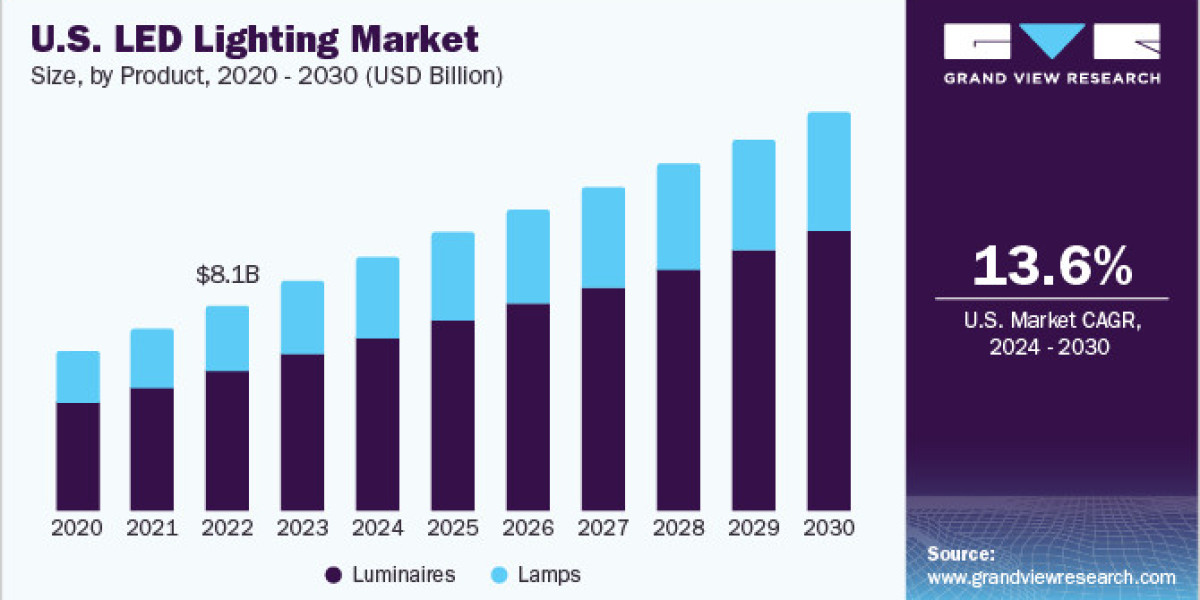With its energy efficiency, durability, and versatility, LED lighting systems has caused a huge expansion of the LED lighting market in the past few years. LED lighting has emerged as a frontrunner, revolutionizing the way people illuminate surroundings. It has swiftly gained prominence across residential, commercial, and industrial sectors, reshaping the global lighting industry.
LED lighting technology converts electricity into light using semiconductor materials. Unlike traditional incandescent or fluorescent bulbs, LEDs emit light in a specific direction, reducing energy wastage and enhancing efficiency. This fundamental principle forms the cornerstone of LED lighting's widespread adoption and success.
Access the LED Lighting Market Size, Share & Trends Analysis Report 2024-2030, published by Grand View Research
Driving Forces
The global LED lighting market had a size value of USD 81.48 billion in 2023. This is expected to reach USD 169 billion by 2030, growing at a compound annual growth rate (CAGR) of 11.0% from 2023 to 2030. There are several driving factors behind the growth of the market. LED lights provide an energy-efficient option. LED lights consume significantly less energy than traditional lighting sources, making them an attractive option for consumers and businesses seeking to reduce electricity bills and minimize environmental impact. With the rising level of construction, the adoption of LED has also risen multifold as the governments are promoting them due to their energy efficiency.
With an impressive lifespan, LED lights outlast conventional bulbs by a wide margin, resulting in reduced maintenance costs and fewer replacements. Moreover, LED lighting emits lower levels of greenhouse gases and contains no hazardous materials such as mercury, aligning with global sustainability initiatives and regulations.
Ongoing advancements in LED technology, including improvements in luminous efficacy, color rendering, and smart lighting capabilities, continue to expand the application scope and appeal of LED lighting solutions. While LED lighting initially carried a higher upfront cost compared to traditional alternatives, economies of scale and technological advancements have driven prices down, making LED lighting increasingly accessible to consumers across various income brackets.
Diverse Applications of LEDs
LED bulbs and fixtures are widely adopted in homes for general lighting, accent lighting, and outdoor illumination, offering homeowners energy savings, aesthetic appeal, and enhanced functionality. From offices and retail spaces to hotels and restaurants, LED lighting solutions are favored for their ability to create inviting atmospheres, optimize workspace functionality, and reduce operational costs.
In industrial settings such as warehouses, factories, and manufacturing facilities, LED lighting's durability, efficiency, and low maintenance requirements make it the preferred choice for enhancing productivity and safety. LED technology also enables dynamic and customizable outdoor lighting designs, illuminating landmarks, bridges, facades, and landscapes with precision and energy efficiency.
Order Your Sample Copy of the LED Lighting Market Size, Share & Trends Analysis Report By Product (Lamps, Luminaires), By Application, By Installation Type, By Sales Channel, By End-use, By Region, And Segment Forecasts, 2024 - 2030
Market Trends & Future Outlook
The LED lighting market exhibits robust growth across regions, with Asia Pacific emerging as a key hub due to manufacturing prowess and increasing investments in infrastructure and urban development. North America and Europe follow closely, driven by stringent energy efficiency regulations and growing consumer awareness of environmental sustainability.
As the industry continues to mature, future developments are poised to focus on enhancing connectivity, automation, and sustainability. Smart lighting systems powered by IoT technology will enable remote monitoring, energy management, and personalized lighting experiences, further revolutionizing how we illuminate our surroundings.
- Connectivity and IoT Integration: The integration of LED lighting with IoT technology will enable the creation of smart lighting systems that offer unprecedented levels of control, customization, and energy efficiency. These systems will allow users to adjust lighting settings remotely via smartphones or voice commands, optimizing comfort, productivity, and energy savings.
IoT-enabled LED lighting solutions will also gather and analyze data on occupancy patterns, environmental conditions, and energy consumption, providing valuable insights for building management and optimization. This data-driven approach will facilitate predictive maintenance, adaptive lighting schemes, and resource allocation strategies, further enhancing operational efficiency and cost savings.
- Sustainable Innovations: With a growing emphasis on sustainability and resource conservation, future developments in LED lighting will focus on circular economy principles, including product design for disassembly, remanufacturing, and material recycling. Manufacturers can explore eco-friendly materials, such as biodegradable polymers and recycled components, to minimize environmental impact throughout the product lifecycle.
Recently, the German government revised its energy plan by shutting down 3 nuclear
power reactors and is rapidly phasing out nuclear-power energy production. The shutdown is expected to result in gaps in energy production. The developments
in the nuclear energy policy are expected to accelerate the demand for renewable energy sources and energy-efficient lighting solutions. Lighting vendors can contribute to the demand for energy-efficient lights by developing more efficient lighting technologies and developing new LED lighting solutions.
Advancements in energy harvesting technologies, such as kinetic energy harvesting and solar-powered lighting, will enable the development of self-sustaining LED lighting solutions. These innovations will enhance off-grid lighting capabilities, particularly in remote or rural areas with limited access to electricity, promoting social equity and economic development.
- Human-centric Lighting: Human-centric lighting solutions are expected to prioritize creating dynamic lighting environments that mimic natural daylight patterns, fostering better sleep quality, mood regulation, and cognitive function. These advancements would have profound implications for various settings, including healthcare facilities, educational institutions, and workplace environments, where lighting plays a critical role in enhancing wellness and productivity.
- Collaborative Ecosystems: Future developments in the LED lighting market will involve collaboration across diverse industries, including technology, architecture, healthcare, and urban planning. Cross-disciplinary partnerships will drive innovation, foster knowledge exchange, and address complex challenges related to sustainability, urbanization, and human well-being.
To conclude, the future of the LED lighting market is characterized by connectivity, sustainability, human-centricity, and collaboration. By embracing emerging technologies, adopting circular economy practices, and prioritizing user-centric design principles, the LED lighting industry is poised to illuminate a brighter, more sustainable future for generations to come.
Acuity Brands, Inc., Cree Lighting USA LLC, Dialight, Halonix Technologies Private Limited, Siteco GmbH, Syska, YEELIGHT, Zumtobel Group Ag, LSI Industries Inc., Nanoleaf, Panasonic Corporation, SAVANT TECHNOLOGIES LLC, Seoul Semiconductor Co., Ltd., and Signify Holding are some of the leading companies in the LED lighting market.
Explore Horizon, the world's most expansive market research database
About Grand View Research
Grand View Research, U.S.-based market research and consulting company, provides syndicated as well as customized research reports and consulting services. Registered in California and headquartered in San Francisco, the company comprises over 425 analysts and consultants, adding more than 1200 market research reports to its vast database each year. These reports offer in-depth analysis on 46 industries across 25 major countries worldwide. With the help of an interactive market intelligence platform, Grand View Research helps Fortune 500 companies and renowned academic institutes understand the global and regional business environment and gauge the opportunities that lie ahead.
Contact:
Sherry James
Corporate Sales Specialist, USA
Grand View Research, Inc.
Phone: 1-415-349-0058
Toll Free: 1-888-202-9519
Email: sales@grandviewresearch.com















